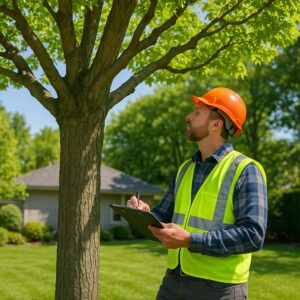When you walk through a lush, tree-lined neighborhood or enjoy the shade of a towering maple in your backyard, you might not give much thought to the health and stability of those trees. However, trees are living organisms, and just like people, they can develop problems that are not always visible to the untrained eye. That’s where a professional tree risk assessment comes in—and why it’s a crucial part of responsible property ownership.
What Is a Tree Risk Assessment?
A tree risk assessment is a systematic evaluation conducted by a certified arborist to identify potential hazards associated with a tree or group of trees. The goal is to determine whether a tree poses a risk to people, property, or other assets and, if so, to recommend actions to mitigate that risk.
Professional arborists use industry-standard methods (such as those outline d by the International Society of Arboriculture) to examine factors like structural integrity, signs of disease or decay, root health, and proximity to buildings or walkways. The assessment is more than just a “quick look”—it’s a detailed process that blends scientific knowledge with years of hands-on experience.
d by the International Society of Arboriculture) to examine factors like structural integrity, signs of disease or decay, root health, and proximity to buildings or walkways. The assessment is more than just a “quick look”—it’s a detailed process that blends scientific knowledge with years of hands-on experience.
Why Are Tree Risk Assessments Important?
1. Protecting People and Property
Trees may look healthy on the outside but could be suffering from internal decay, disease, or root problems that make them susceptible to falling—especially during storms or high winds. A single failed limb or toppled tree can cause serious injury or property damage. Regular risk assessments help identify these hidden dangers before they become emergencies.
2. Liability Concerns
As a homeowner or property manager, you are responsible for maintaining the trees on your land. If a tree or large limb falls and causes harm, you could be held liable for injuries or damages—especially if it’s determined that the hazard was known or should have been addressed. Documented risk assessments show that you’re taking proactive steps to protect your property and neighbors.
3. Preserving Tree Health and Longevity
Not every at-risk tree needs to be removed. In many cases, a risk assessment can help identify targeted interventions—like pruning, cabling, or soil improvements—that support the health of the tree while reducing danger. Catching problems early means you can often save mature trees rather than losing them to preventable issues.
4. Peace of Mind
Perhaps the most significant benefit is peace of mind. Knowing that your trees have been professionally evaluated allows you to relax and enjoy your landscape, confident that you’re doing your part to keep your property safe and beautiful.
What Does a Tree Risk Assessment Involve?
A thorough risk assessment typically includes:
-
Visual Inspection: The arborist examines the trunk, branches, leaves, and root zone for signs of decay, disease, or structural weaknesses.
-
Site Evaluation: They assess the tree’s surroundings, including nearby structures, power lines, and foot traffic.
-
Risk Rating: Trees are assigned a risk level based on the likelihood of failure and the potential consequences.
-
Recommendations: You’ll receive a clear report with suggested actions, which might range from pruning or cabling to full removal (in extreme cases).
When Should You Schedule a Tree Risk Assessment?
-
After major storms (especially if you notice cracks, leaning, or broken branches)
-
Before starting construction projects near trees
-
If you see signs of disease or decay
-
As part of regular landscape maintenance, ideally every few years
Trust the Professionals
Tree risk assessment isn’t just a box to check—it’s an investment in your property’s safety, beauty, and value. At New Day Arborist, our certified arborists are trained to spot risks that others might miss and offer practical solutions that fit your needs and budget. Whether you have a single backyard tree or a whole grove, we’re here to help you keep them healthy and safe for years to come.
Need a tree risk assessment or have concerns about a specific tree on your property?
Contact New Day Arborist today for a professional evaluation and expert advice.